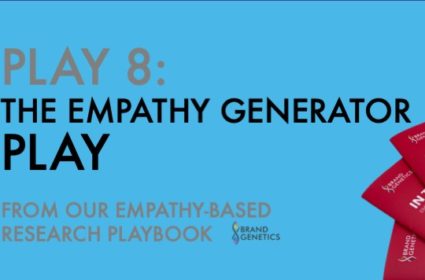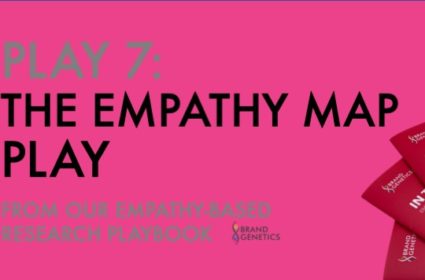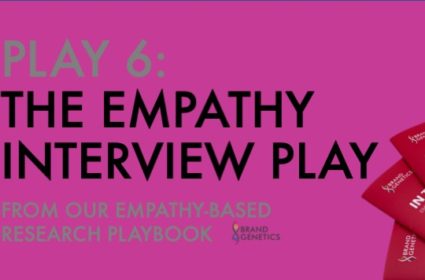Empathy defined (list of definitions)

This article is part of our series on Empathy- based Research. You can view the full series or download the report.
At Brand Genetics, we use empathy as a qualitative research technique to help our clients understand their consumers. Applied empathy helps us reframe a challenge from a consumer perspective, and in doing so reveal new opportunities. But what exactly is empathy?
Beyond metaphor
The metaphors of ‘standing in someone else’s shoes’ and ‘seeing through someone else’s eyes’ are often used to describe empathy. These metaphors are evocative, but empathy is also a specific mental ability, like intelligence. In essence, empathy is the ability to feel and understand what someone else is feeling.
Empathy is emotional insight
Empathy is a mental ability that produces emotional insight, allowing us to feel and understand the emotional world of someone else.
The term empathy is actually a translation of the German word “Einfühlung”, which quite literally means emotional insight (in-feeling). German philosopher Theodor Lipps coined this term “Einfühlung” in 1903 to denote our mental ability to project ourselves into the body of someone else and feel what they are feeling.
For example, when we observe the adrenalin-pumping performances of an acrobat, we project ourselves into them, and “we feel ourselves inside the acrobat”. The German “Einfühlung” was translated into “empathy” the following decade by British psychologists James Ward and Edward Titchener. Today, the Cambridge English Dictionary defines empathy in a way that is consistent with this original understanding as “the ability to share someone else’s feelings or experiences by imagining what it would be like to be in that person’s situation.”
List of Empathy Definitions
Just as you have an IQ (intelligence quotient), you have an EQ (empathy quotient) which measures your capacity for emotional insight – the ability to feel and understand what someone else is feeling.
For over a century, scientists have been researching empathy, both as a partially genetically inherited personality trait and as a learned skill. Over this time, they have adopted a number of definitions of empathy to delineate empathy from related terms such as sympathy, emotional intelligence and compassion.
Here’s a useful list of definitions that capture the essence of empathy.
- “Empathy is our capacity to grasp and understand the mental and emotional lives of others” Susan Lanzoni (2018)
- “Empathy is about understanding. Empathy lets us see the world from other points of view and helps us form insights that can lead us to new and better ways of thinking, being, and doing” Micheal Ventura (2018)
- “A capacity for ‘positional thinking,’ the ability to see the world from another creature’s viewpoint” Martha Nussbaum, (2016)
- “Empathy has two components: “cognitive empathy”, the ability to recognize or infer what another person is feeling, including whether they are suffering; and “affective empathy”, our emotional response to their thoughts and feelings, which impels us to action (e.g., to reduce their suffering)” Simon Baron Cohen (2016)
- “Empathising is about spontaneously and naturally tuning into the other person’s thoughts and feelings, whatever these might be.” Simon Baron Cohen (2004)
- “The capacity to (a) be affected by and share the emotional state of another, (b) assess the reasons for the other’s state, and (c) identify with the other, adopting his or her perspective” Frans De Waal (2008)
- “The capacity to understand and enter into another person’s feelings and emotions or to experience something from the other person’s point of view” Andrew Colman (2015)
- “Empathy has been used to refer to two related human abilities: mental perspective taking (cognitive empathy, CE) and the vicarious sharing of emotion (emotional empathy, EE)”. Adam Smith (2006)
- “Empathy is the art of stepping imaginatively into the shoes of another person, understanding their feelings and perspectives, and using that understanding to guide your actions” Roman Krznarik (2014)
- “Vicariously catching someone’s feelings—known as “emotional empathy”—and thinking about what they feel—”cognitive empathy” Jamil Zaki (2019)
- “Empathy – the ability to understand and share in the internal states of others – is a complex, multidimensional phenomenon that includes a number of functional processes, including emotion recognition, emotional contagion, and emotion priming” Leonardo Christov-Moore (2014)
- “Empathy is about acquiring feelings. The goal is to feel what it’s like to be another person” Jon Kolko (2014)
- “Empathy is an emotional response (affective), dependent upon the interaction between trait capacities and state influences. Empathic processes are automatically elicited but are also shaped by top-down control processes. The resulting emotion is similar to one’s perception (directly experienced or imagined) and understanding (cognitive empathy) of the stimulus emotion, with recognition that the source of the emotion is not one’s own” Benjamin Cuff (2014)
- “For us, it’s the ability to see an experience through another person’s eyes, to recognize why people do what they do. It’s when you go into the field and watch people interact with products and services in real time—what we sometimes refer to as ‘design research’.” David Kelley (2013)
- “Feeling a congruent emotion with another person, in virtue of perceiving her emotion with some mental process such as imitation, simulation, projection or imagination” Julinna Oxley (2011)
- “Empathy can be understood as a sense of knowing the personal experience of another person” Lisbeth Goubert (2009)
- “The tendency to vicariously experience other individuals’ emotional states” Paolo Albiero (2008)
- “The understanding and sharing in another’s emotional state or context” Douglas Cohen (1996)
- “Cognitive empathy will be understood as the ability to construct a working model of the emotional states of others, and affective empathy will be understood as the ability to be sensitive to and vicariously experience the feelings of others” Renate Reniers (2011)
- “A shared emotional experience occurring when one person (the subject) comes to feel a similar emotion to another (the object) as a result of perceiving the other’s state” Stephanie Preston (2006)
- “Empathic understanding is placing oneself imaginatively in another’s experiential world while feeling into her or his experiences with the aim of comprehending these experiences” Hans Alma (2006)
- “Empathy is a complex form of psychological inference that enables us to understand the personal experience of another person through cognitive/evaluative and affective processes” Nicolas Danziger (2006)
- “Empathy is the ability to imagine yourself in someone else’s position and to intuit what that person is feeling” Daniel Pink (2005)
- “Empathy denotes, at a phenomenological level of description, a sense of similarity between the feelings one experiences and those expressed by others” Jean Decety (2004)
- “The ability to understand and share in another’s emotional state or context” Douglas Cohen (1996)
- “Sharing another’s feelings by placing oneself psychologically in that person’s circumstance” Richard Lazarus (1994)
- “Empathy is a process for understanding an individual’s subjective experiences by vicariously sharing that experience while maintaining an observant stance” William Zinn (1993)
- “The capacity to know emotionally what another is experiencing from within the frame of reference of that other person, the capacity to sample the feelings of another or to put oneself in another’s shoes” David Berger (1987)
- “The process by which one person is able to imaginatively place himself in another’s role and situation in order to understand the other’s feelings, point of view, attitudes, and tendencies to act in a given situation” Raymond Gordon (1987)
- “The state of empathy, or being empathic, is to perceive the internal frame of reference of another with accuracy and with the emotional components and meanings which pertain thereto as if one were the person, but without ever losing the “as if” condition” Carl Rogers (1980)
- “The psychological state of imaginatively projecting oneself into another’s situation” Theodor Lipps (1903)




